Inside the Very Peculiar and Wildly Popular World of Armored Medieval Combat

“Fighters, touch tips!” master of ceremonies Mickey Gallus booms over a loudspeaker. The clunky innuendo elicits a roar from the Saturday-night crowd inside Hammond Civic Center. Violence looms, and the prospect seems to thrill the throng of thousands. In the middle of an MMA-octagon-style ring called the cage, two men dressed as knights from the Middle Ages nobly oblige. They bump their longswords together—actual bone-crunching, tendon-crushing, sinew-splicing swords—before retreating to their corners.
In one corner is thirty-seven-year-old Matt Gifford, five foot ten inches, weighing in at 185 pounds. Over his armor, he wears a red brigandine, a cloth garment studded with metal. On the other side of the cage is forty-seven-year-old Jason Bryant—five foot seven, 155 pounds—in a black brigandine. They’ve just swaggered into the cage through thick smoke, hitting video game taunts for the crowd. They’re both armored up to the extreme: backplates, pauldrons, vambraces, greaves, sabbatons. Tonight they are Arthurian knights, with scores to settle.
“Fighter number one, are you ready?” A nod of the helmet. “Fighter number two, are you ready?” A flourish of the sword. “And Hammond, are you ready for the first match of the evening?” Pandemonium. “Aaaaaaaaaand, start fighting.”
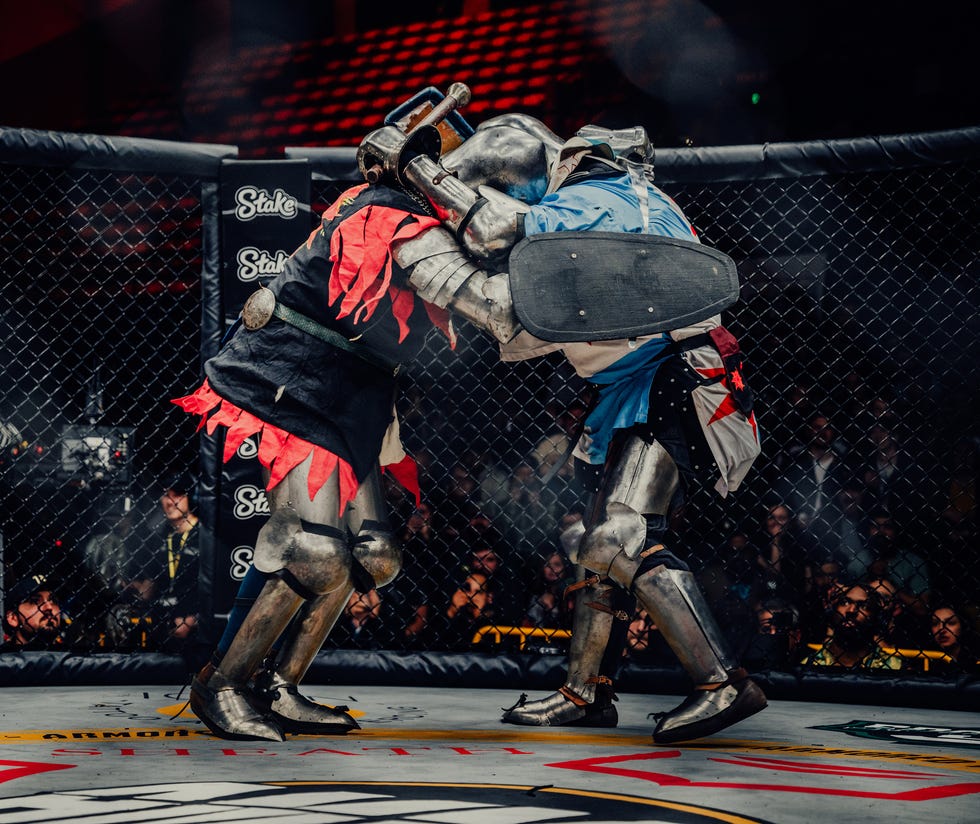
Fighters in full battle gear going at it hard at an Armored MMA event in Hammond, Indiana, on a recent Saturday night. The emerging sport is like mixed martial arts, but with swords, shields, and battle-axes. Lead image: Jason Bryant strides forth, entering the cage for his bout.
Battle commences. The sound of clinking metal ricochets around the arena. Chunks are taken out of unwieldy armor, which is so cumbersome it makes combination maneuvers exceptionally challenging. But the lumbering movement gradually finds momentum and becomes strangely hypnotic. It’s like watching a fight in slow-motion. Round one is a scrappy affair. But within seconds of round two, Bryant piledrives Gifford, who sinks to the floor like a sack of potatoes. The crowd roars. Gifford doesn’t get up. “Finish him!” a man behind me bellows. “Poke his eye out!” yells another. He wants a Harold-at-Hastings ending, worthy of a tapestry—or, for now, an Instagram Story.
Welcome to Armored MMA, or AMMA, a combat sport surging in popularity. It’s a one-on-one cage fight in which warriors are outfitted in medieval armor and use genuine weapons. “Medieval combat meets modern MMA,” goes the tagline. Fighters win by scoring the most points, by a technical knockout, or by a skull-shaking knockout, which is rare and the best-case scenario for bloodthirsty crowds. There are rules. Thrusting your weapon, for instance, is not allowed, nor is choking out an opponent. All of it—the weapons, the armor, the violence—is real. If a fighter falls to the floor, they have fifteen seconds before the ref yanks them up. Otherwise, the fight is over.
Tonight’s event in Hammond, Indiana, a town about thirty minutes from Chicago, features eleven fights: six exhibition matches (three rounds, one minute each) and five professional bouts (three rounds, two minutes each). The spectacle kicked off when a loudspeaker goaded: “WHO. WANTS. VIOLENCE?”
Mere minutes into the first match, I’m baying for more. It’s hard not to get swept up in the bellicose atmosphere and forget about the gruesome consequences. Around me there are jocks with peach-fuzz chinstraps; middle-aged men into the Middle Ages; children who’ve been dragged along by their parents; women glammed up for a party; fantasy nerds protected by furry ear defenders. It’s date night, family night, game night, and fight night all rolled into one—a boisterous evening in the beating heart of America.

In Armored MMA, the weapons are made of real metal to specifications similar if not nearly identical to those forged in the Middle Ages. The edges are blunted, however, to avoid someone chopping off a limb. Still, the fighters are wielding heavy metal, as the sport’s forebears did.
We’re all waiting for Bryant to finish off his opponent. Suddenly, referee Ricky Rayome, a stocky man in a hockey-style helmet, plunges a yellow-and-black flag into the brawl. He stops the fight. It’s a technical knockout due to a dislocated shoulder.
Gifford writhes around like an overturned pill bug trying to flip back up. His right arm is impossibly twisted, hanging limp at his side like a broken action figure’s. He’s carried off.
Unfortunately for Gifford, Indiana law prohibits EMTs from popping a shoulder back into place. For the rest of the night, he lies on the floor backstage surrounded by crates of armor as a medic tends to his useless limb. We can hear him groaning from high in the bleachers, like a wailing siren in the distance.
As you’ve likely surmised, Armored MMA is a peculiar thing. It is a combat sport with weapons from the Middle Ages, costumes from Medieval Times, and a growing audience thanks to social media. There’s a strong chance you’re among the millions of people who have seen an AMMA video while scrolling on Instagram. It inspired me to plan a quest from the Rainy City (Manchester, England) to the Windy City (Chicago, Illinois) to witness it in the flesh.
What did I find? On the surface, a carnival of violence. But beyond the spectacle, I discovered an unlikely community of fighters and outcasts, medieval enthusiasts and curiosity seekers, all bound together by two entrepreneurs to whose lives this unusual sport has given meaning and purpose. Together, they’ve built a combat league for people who’ve soured on the UFC and the manosphere surrounding it. And they’re working their asses off to keep the whole thing afloat.
You might call it Camelot for misfits.
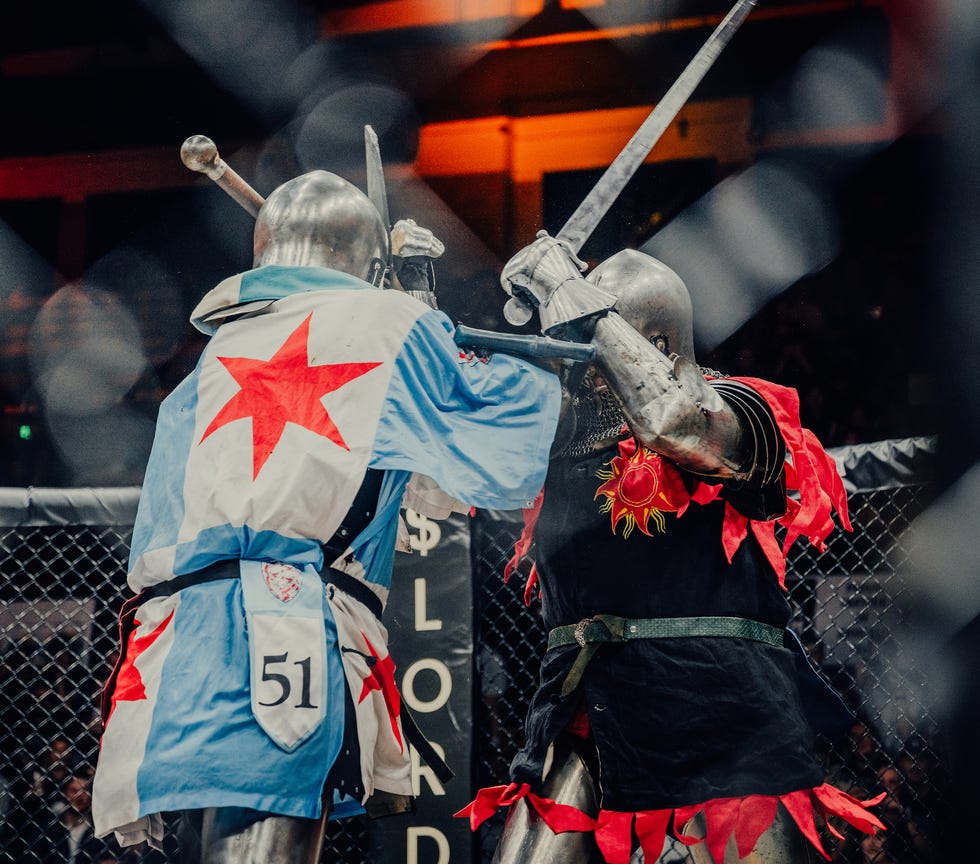
Armored Medieval Combat dates back to the twelfth and thirteenth centuries, when knights sought to fill their downtime with even more fighting. Today, thousands of people turn out to watch people dressed as knights fight each other in an octagon.
The sport itself is hardly new. AMMA is a form of Armored Medieval Combat (also known by myriad other, similar names). It’s not LARPing (Live Action Roleplay), in which participants gallivant around fields, play-fighting with foam weapons. And it’s not reenactment, which is a technical and far safer reconstruction of a medieval fight for castle-goers. There are elements of both, but Armored Medieval Combat is a contact sport with scoring. The weapons—swords, axes, maces, spears, and shields—are made of real metal to specifications similar if not nearly identical to those forged in the Middle Ages. The edges are blunted, however, to avoid someone chopping off a limb. Still, the fighters are wielding heavy metal, as the sport’s forebears did.
The timeline of Medieval Combat as a sport starts in the twelfth and thirteenth centuries, when knights sought to fill their downtime with even more fighting. (You could go back to Roman gladiators, but they were literally killing one another.) The knights practiced Buhurt (“bow-hurt”), essentially jousting without the horses. Their training weapons were often blunted too. Anything was allowed, and fighters lost when they were thrown to the floor. It was meant to simulate actual warfare for knights; if you fell over on the battleground, you were likely staring into the lifeless eyes of the Grim Reaper. “Someone would stand on your chest while their friend pokes holes in you,” Daniel Winter, the owner of Armoured Martial Arts in Nottingham, England, told me.
Occasionally, denizens of medieval Europe used Buhurt to resolve disputes to avoid messy bloodshed. When the Renaissance turned everyone bookish, this brutality fell out of vogue. Five hundred years later, however, Buhurt enjoyed its own renaissance. Russian oligarchs developed a taste for medieval battle in the 1990s and began to burn cash on major brawls with hundreds of people.
In 2010, the first Battle of the Nations was held in Ukraine, a gargantuan outdoor competition that was held every year in Europe until 2022. The sport was formalized in 2014 with the first International Medieval Combat Federation world championship in Spain. Clubs from across the world were part of the Russian-based organization Historic Medieval Battles (HMB), but in 2022, when Russia invaded Ukraine, every country aside from the Putin-sympathizing Belarus cut ties and formed a new organization called Buhurt International (BI). Scores of different groups with confusingly similar acronyms are part of larger national networks, which are part of BI. There’s frequent griping among the various groups, which is why they’re constantly trying to usurp one another as the organization for Medieval Combat.

Mickey Gallus, one-half of the couple that started Armored MMA, perches on the rim of the cage, working the crowd at the Hammond Civic Center.
AMMA is a start-up in the world of armored combat. It brought the fight inside, threw knights into the cage, and dialed up the drama. This year, AMMA has been on the road for its Medieval Cage Fighting Championship USA 2025 Tour. It began last month in the sport’s spiritual home: Nashville. Over the summer and fall, AMMA will visit Houston; Phoenix; Canton, Ohio; and Portland. I attended the tour’s second stop, at Hammond Civic Center, a forty-five-hundred-capacity sports arena with a long history of hosting WWE, roller derby, and collegiate basketball.
Carl Sandburg dubbed Chicago the city of big shoulders. Tonight, Hammond is the city of busted ones.
Five minutes before Matt Gifford dislocates his shoulder—the first of four dislocations that night—Mickey Gallus lays down the law. The thirty-six-year-old is not only the night’s MC but also a cofounder of AMMA. “This is a very real sword in my hand,” he says from the center of the cage, sounding like Macbeth on creatine in his feathered hat, American-flag poncho, and boots. With the crowd’s attention upon him, he brandishes a longsword. “If it flies out,” he continues, waving his weapon, “the cage will protect you.”
He tosses the sword into the air to demonstrate. It clangs into the fencing behind him, directly in front of a producer, who flinches. “I’m so sorry,” Gallus says, laughing maniacally. He vaults the cage and straddles its perimeter. “These guys will be beating the crap out of each other for your entertainment . . . pick a fighter and make him yours, right?” Gallus is a natural entertainer.
Before the event, I meet with Gallus in a sparse room in the upper portion of the civic center. Up close, he’s strikingly handsome, with a prize mullet and a golden voice. He’s bordering on burnout, but there’s an intensity in his eyes that’s offset by a glint of fragility. With him is Kelsey Leta, thirty-two, a cofounder of AMMA. Gallus is reluctant to talk about their personal lives but describes her as his “partner in fighting, business, and life.” Shaven-headed and elfin, she’s armed with an equally attractive, acerbic sense of humor. Their two puppies, Peyote and Casper, watch on with tails wagging.
Armored Medieval Combat isn’t for the faint of heart, but it took a crippling cardiac condition for Gallus to get involved in the sport. In 2016, his heart had “started acting up” and would begin changing speeds and hurting. It grew increasingly worse, progressing from infrequent episodes to “nonstop” issues. Gallus was also juggling “tons of jobs” while working as a musician before settling as a freelance marketing consultant to help up-and-coming bands.
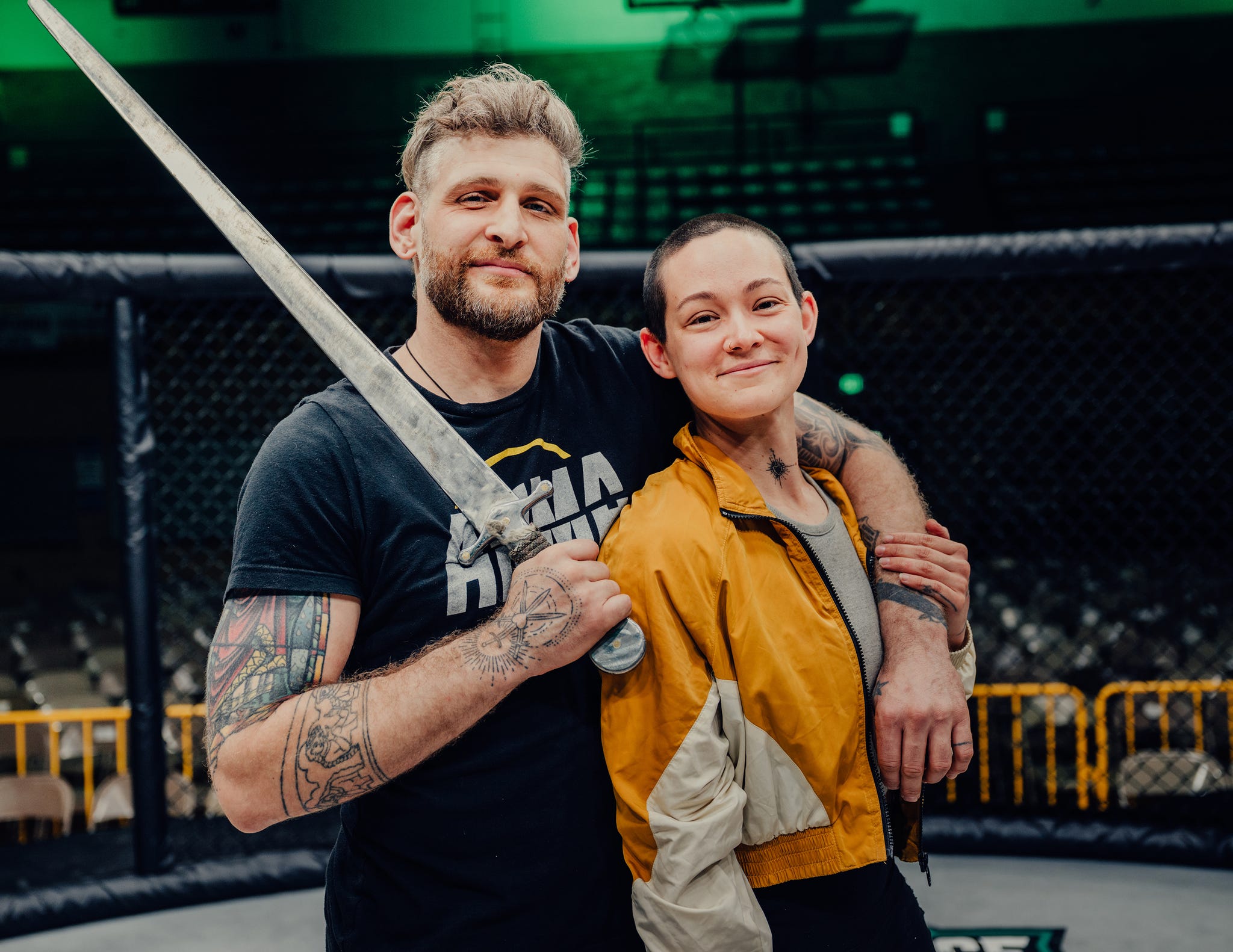
Mickey Gallus and Kelsey Leta, the Nashville couple who cofounded Armored MMA.
After catching a story on local TV about a Nashville group of fighters, Gallus thought taking up the activity might help his heart problems. Immediately, he went all in—bought a handmade helmet online (which was half decent, he says) and some ill-fitting armor and joined the group of fighters in Nashville. He also traveled to Memphis to learn sword work from Nicholas Homa, a champion Armored Medieval Combat fighter.
After just a two-week crash course, Gallus drove to New Hampshire to watch a tournament. He ended up participating—and took home a gold medal. “I didn’t even know what the hell I was doing,” he says. “I just went in there and swung the sword the exact way I was taught and pretended the other person in front of me wasn’t there.”
The team event, in which multiple people fight at once, was another story. Gallus was beat to a pulp and couldn’t lift his arms for a week. He was shocked they let him participate. “You shouldn’t throw somebody in there at a semifinal championship against one of the best teams in the entire fucking world and hope they do okay,” he says.
The experience revealed something to him: If American hobbyists wanted to take the sport further, they needed to learn techniques rather than just wing it. He continued training at far-flung facilities, bringing the knowledge back to Nashville. One half of the group in Nashville wanted to just fuck around, according to Gallus. But the others were dedicated to honing their skills. Then Covid tore through the U.S. Lockdown orders meant Gallus and his fighters couldn’t meet indoors. So he stacked a load of tires on his back porch and invited people to train during the week.
Gallus had fallen in love with beating the shit out of other would-be knights. But one year into Armored Medieval Combat, his heart condition wasn’t improving. He underwent a series of surgeries until the doctors brought it under control. Now Gallus has to be careful with caffeine, alcohol, stress, and, perhaps most difficult of all, working too much.
Meanwhile, Kelsey Leta saw a training video of a woman named Megan Themm, who was the first woman to put on the armor at Gallus’s tire arena. Leta was a student in psychology at the time, and she says she “didn’t have a whole lot of goals or plans.”
The fighter writhes like an overturned pill bug trying to flip back up. His right arm is impossibly twisted, hanging limp at his side LIKE A BROKEN ACTION FIGURE’S.
She became enamored with the sport and started showing up to train. “Everything changed,” she says, “and felt like home.” A year later, Leta and Gallus started dating. Mondays became dueling days for women in the hope that more would join the sport. It remains an entrenched tradition. “He’s the first person who saw me for exactly who I am and what I could be,” Leta says of Gallus. “He’s always believed in me since the very beginning, and I wouldn’t have made it this far in this sport without him.”
By February 2021, Gallus and Leta had found a space in the back of an ax-throwing place. Wednesdays became fight nights, with friends and family invited to drink beers and watch them spar. The ax throwers eventually kicked them out—the crowds were getting too big—so Gallus, Leta, and their fighters moved to a buddy’s backyard to train. Then an epiphany: Gallus went to Vermont for a few days and returned with a business plan for a gym. Dozens of fighters chipped in for a ten-thousand-square-foot space in Nashville, half for training, the other half for hosting events.
There were already tournaments across the U.S. attracting several hundred spectators at a time. But they were held outside, and according to Gallus the events were often poorly run with lax officiating. Also, Leta was annoyed that many of the fights weren’t female friendly. “There was a lot less appreciation and opportunity for trans and femme fighters,” she says, explaining that women’s melees were frequently canceled at the last minute. At one recent fight, a parking lot was offered instead of a proper fighting cage.
It took staging more than forty events in the new Nashville location for Gallus and Leta’s group to find its footing and its form. The first show under the rubric Armored MMA—what Gallus calls AMMA Zero—took place in November 2022. At the end of that year, a manager of one of the bars down the street stumbled across AMMA. “He was like, What the fuck, yeah,” Gallus says. He bought front-row tickets for himself and everybody he could bring for months at a time. Wanting to help, he offered space in his honky-tonk to Gallus and Leta. The last Wednesday night of the month became AMMA night.
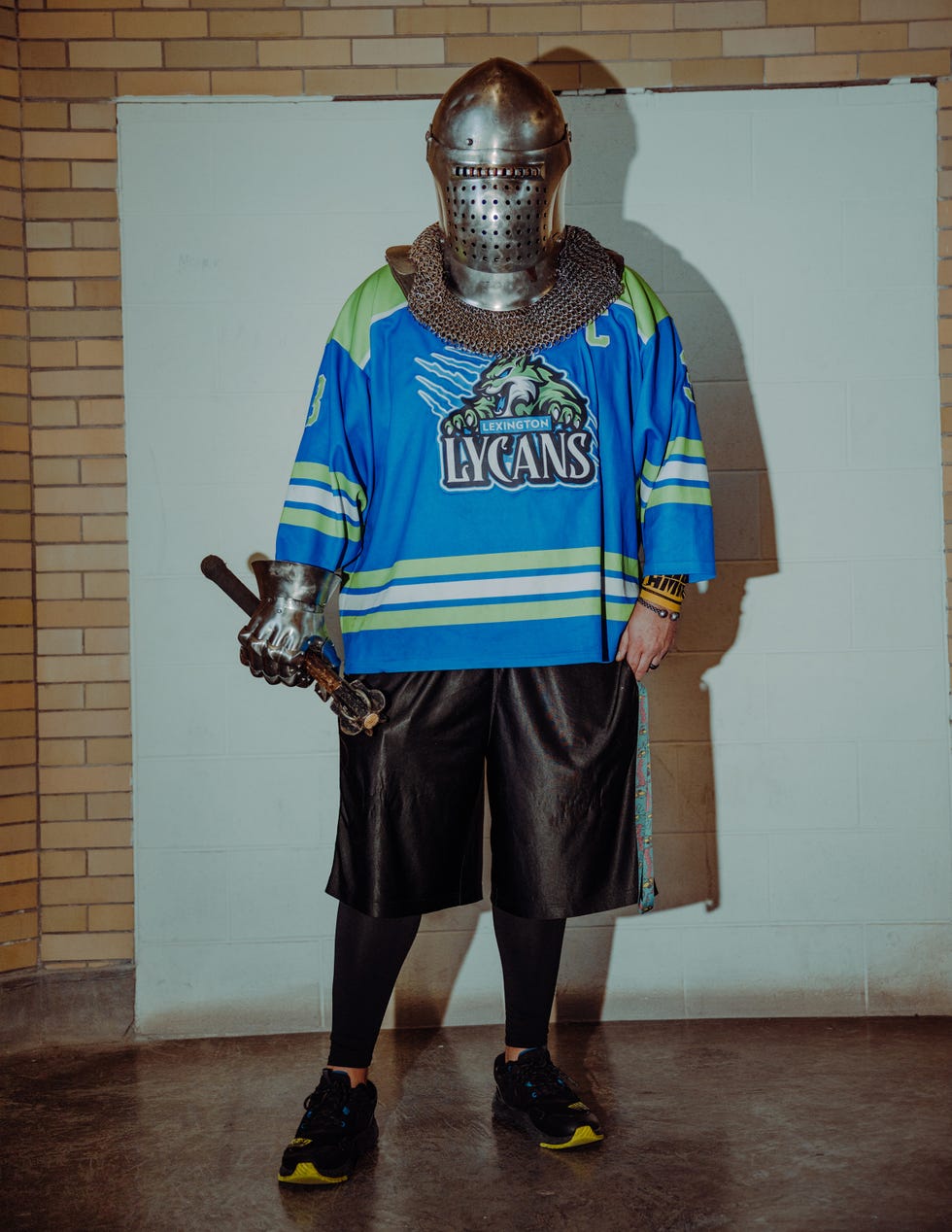
A fighter showing elements of armor mixed with some more modern-inspired sports gear.
This year, AMMA went on tour for the first time, enlisting fighters from various leagues and gyms across the world. “We’re having a good problem, where fighters are getting so much better,” Rayome, the referee, tells me backstage. Word of mouth helped build a wider audience, but social media clearly expanded its reach exponentially. In June 2024, AMMA had only a thousand followers on Instagram. Now it boasts more than 645,000. “We had a highlights reel that popped off and it looked really good,” Gallus said. As someone who stumbled across this and ended up on a plane to Chicago to see more, I heartily concur.
At first, most of the audience members thought the fighting was staged. Many still do. But you determine quickly after seeing a busted nose or a decimated limb (Gallus usually fights at AMMA but is out with a knee injury) that these aren’t chivalrous charades. He shares a story about a fighter, Simon, whose helmet fell off and he took an ax to the head. “He had a big, thick skull, so that saved his life,” Gallus says. Now the mandatory connecting strap from helmet to torso is called a Simon Strap. Armor malfunctions remain a nagging issue for AMMA, though. During one of the fights in Hammond, terrifyingly, a helmet slips off. The AMMA crew is vigilant, with someone always on hand to check armor and weapons throughout fights. It’s necessary for safety, but it does make the bouts a bit stop-start.
The brutality of the sport makes AMMA closer in spirit to UFC than to WWE. Yet Gallus and Leta bristle at this comparison. “UFC has become really toxic,” Gallus says. “In general, the idea of toxic masculinity in sports has been awful. Like, yeah, you got to be a shit talker and whatever. Really, you don’t.” Instead, AMMA is attracting audiences put off by Dana White’s dumb machismo. “It’s for the people that were left out with that,” he says, emphasizing the importance of respect.

Ashley Shadu Fry, moments before her fight.
Earlier in the night, I catch Gallus helping the crew with setup. He goofs around with fighters, shadow-fencing and showing off feints; but he’s also hard at work with literally every part of the operation. “He’s putting stickers up!” Jesse Nunez, an MMA promoter and now the head of production for AMMA, tells me. “He shouldn’t be—he runs the show! But we’re passionate.” I can’t imagine Dana White crawling under the ring to recover a lost bolt. Nor can I envisage UFC’s kingpin ever fighting inside the ring—something both Gallus and Leta do on a regular basis.
Nunez is eager to advance AMMA. He’s all too aware that competitors will be lurking in the shadows. But Gallus doesn’t want endless growth. He simply wants the people involved to earn a living. “We’re just fighting to exist,” he says. And he’s making it more accessible for knights in the making, offering financing options to share the cost of the exorbitantly expensive armor. Next year, he says, is about dialing it back so he can make sure not to overdo it—remember the heart condition—plus, the paperwork, licenses, and sanctions are a headache. Gallus sighs and hunches his shoulders. It’s a lot of responsibility to carry. If someone offered him a million dollars so he didn’t have to load the cage or handle promotions, video, and most of the other details, he says he’d accept it.
One thing seems certain: AMMA will continue to grow in popularity. Gallus and Leta have turned Armored Medieval Combat into an all-American spectacle. The tour features ads for a new AMMA video game called Blob Arena and an app that allows users to predict a winner in each fight. Before the Hammond bouts, a Corona sponsorship comes in at the eleventh hour. Angel investors must be waiting in the wings.
For Leta, AMMA’s popularity is about striking a fine balance between peace and war. “People love violence but don’t always want to participate in it,” she says. “But we also balance that out with the chivalry aspect. So we’re giving them both things that they need, where it’s like, I need to see something completely and totally fucking unhinged, because the world is unhinged and I don’t know what to do, but then we balance it with, Oh shit, they hugged after they tried to kill each other.” They have, she believes, “welded together” violence and benevolence.
Whether it’s the swords, the chivalry, the spectacle, or, as Leta suggests, a combination of all three, the strategy is working: AMMA has found legions of fans. In the beer line in Hammond, a woman adorned in medieval-adjacent silver jewelry bumps into a former classmate. “Of course you see someone from high school at your first Armored Medieval Combat fight,” she sighs. I ask them what they think. “I think . . . they’re really fighting,” one of the women says. Elsewhere, I talk to two guys named Ben and Bryce. “Someone must have been at Medieval Times and been like, Wait a minute, there’s more,” Ben says. “It’s like, Hey, hurt each other. That’s how it was back then.”
Throughout the night, a drone whizzes above the crowd. People point, smile, and wave at it, like they’re on Fancam. It’s a powerful image, because for some Medieval Combat enthusiasts outside the U.S., real warfare has become part of their everyday lives. But there’s no escaping the cage.
Mykola Avenirov, a thirty-three-year-old man with cropped hair and dashing looks, entered the world of Armored Medieval Combat in 2011 as a fighter. After participating in hundreds of tournaments, he realized how difficult it was to find reliable gear. So in 2017, he started MedievalExtreme in Ukraine, an armor manufacturer that’s grown into a global business. In fact, nearly all the armor used in Buhurt is made in Ukraine by specialized workshops. MedievalExtreme offers the full package, from design to custom fitting through to final production.
Most of the fighters with whom I speak in Chicago regularly order from MX or a different Ukrainian manufacturer, valuing their reliability and quality, honed since the ’90s Buhurt revival in Eastern Europe. It’s important to get bang for your buck—a full set of armor can cost $5,000, and you don’t want to be buying a helmet from Amazon. It’s far safer to trust professional smiths. Now MX is forging a closer alliance with AMMA, with plans to offer products specifically for its fighters.
When Russia invaded Ukraine in February 2022, fantasy became entangled with reality. Suddenly, many Ukrainian armor smiths were forced to engage in actual combat. “The war has changed everything,” Avenirov says. “Many of our team members joined the army, and we do everything we can to support them.”

A fighter descends into the cage for the final match of the night.
Despite the war, MX continues to supply the world’s Medieval Combat enthusiasts. And according to Avenirov, physiotherapists are using Medieval Combat to rehabilitate Ukrainian veterans. “They help war veterans regain their strength and find purpose again through armored combat,” he says.
Back in Chicago, the fighters recognize this strange duality. “There are a lot of smiths we can’t go through anymore because they lost workers who went to war and ended up dying. It’s awful,” Nathan Kitchen, a fighter from Ohio, tells me backstage. “It’s impacted us, but on the other end of it, these people are getting bombed.”
Of course, most people across the world who participate in Armored Medieval Combat aren’t using it to recover from the psychological impact of an actual battlefield. The closest many have come to real combat is taking a mace to the helmet. Some detractors, then, may question the appeal of spending thousands of dollars to get thwacked in the head with a barbaric implement. As ever, there is a perverse pleasure in the pain. The majority of people don’t enjoy being pummeled. But a curious group of humans do.
The meeting room of the Hammond Civic Center looks like a teenage boy’s bedroom. Subway sandwich wrappers, bottles of Gatorade, and gym bags are littered everywhere. “It stinks in here!” Rayome, the referee, says as he pokes his head in. Among the detritus are the tools of the trade—weapons, armor, regalia—as well as tonight’s fighters. There’s electricity in the air (or whatever the medieval equivalent), with fighters discussing grappling strategies and strapping up their weapons. They are bags of adrenaline and jangling nerves. Then, just before entering the cage, they put on their helmet, which is always a tense moment.
Nearly every fighter with whom I speak alludes to something they avoid saying out loud, fearing they will jinx themselves: helmet horror. It’s a term to describe the claustrophobic, panic-attack-inducing feeling some people experience when their face is encased by a twenty-pound lump of steel. It feels like being waterboarded by metal.
But most of these fighters seem to get off on the pain—combat is a hell of a drug. Leta recalls headbutting a fighter and feeling bad afterward. But the fighter said: “Don’t worry, that was awesome. Do it again.” It’s why many make the move from LARPing—they’re looking for a stronger high.
On the other side of the coin, some fighters come from MMA, attracted by the lore. Many people fantasize about being a knight. And it’s never been more stylish. (See: Chappell Roan’s medieval-themed VMAs performance and Burberry’s front-row knight at its autumn/winter ’25 show.) But no one here is reading Harper’s Bazaar. Everyone with whom I speak has a different reference point—usually Game of Thrones, Lord of the Rings, or an obscure cultural reference.
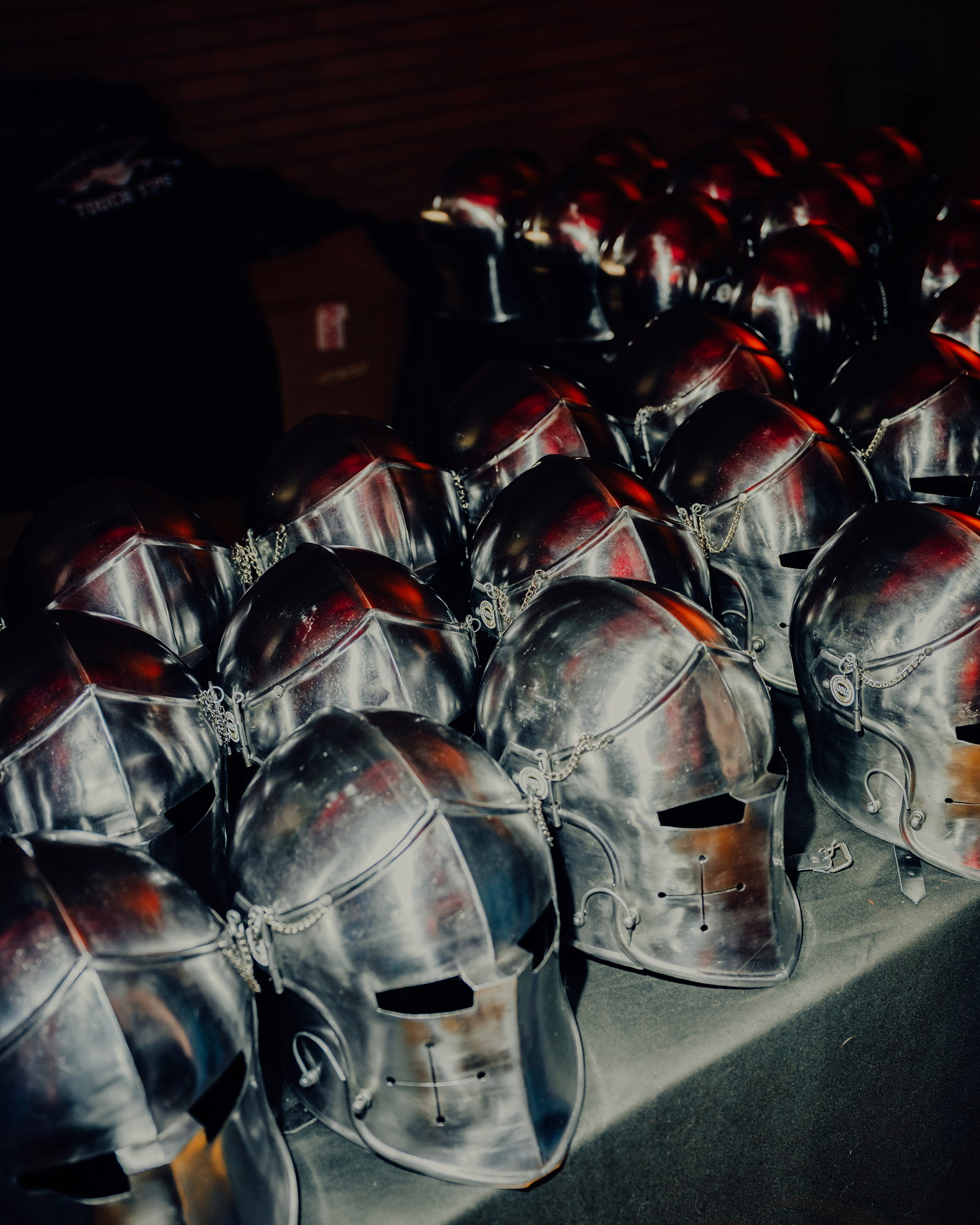
Helmets on display for purchase at the fight night in Hammond; each one goes for about $150. Many fighters report experiencing “helmet horror,” a claustrophobic, panic-attack-inducing feeling that can well up when you first encase your head completely in the heavy steel armor.
Armored Medieval Combat is, essentially, for geeks with serious mettle. Kristina Knizner, the girlfriend of Nathan Kitchen, the fighter from Ohio, is amused when she tries explaining it to her friends. “It’s MMA, but the nerdy kind,” she says. Rayome calls it “weaponized autism.” He’s not being flippant—a significant proportion of the AMMA crew are neurodivergent and like to joke about it.
Daniel Winter, the Armoured Martial Arts owner, agrees. “We’re sporty people, but we’re also massive nerds.” The UK-based fighter plays Warhammer and Magic: The Gathering. Historically, the worlds of MMA and medieval enthusiasts rarely crossed paths. If Winter had told one of his nerdy friends he was going to an MMA fight, they’d say, “What the fuck do you mean?” Now it’s socially acceptable to be geeky and built, he says. It’s clear that the sport fosters a sense of community and belonging, coming at a time of extreme social isolation, especially for men. And it gives the self-proclaimed nerds an outlet, other than the tabletop, to let off steam. A unique chance to becomethe character.
I head over to the merch table and meet Dawn Stiers and Spencer Waddell, who are arranging helmets. Stiers, who is quiet and friendly, is a member of the Society for Creative Anachronism, which studies and re-creates medieval culture. Waddell, meanwhile, is an incredibly eloquent and welcoming fighter, a manager of Gallus and Leta’s gym and a member of the Knights of Wakanda, which is helping to bring fighters from the African diaspora into Armored Medieval Combat. He’s a self-confessed geek, showing me his black nerds baseball cap.
It’s clear that AMMA fosters a sense of community and belonging, coming at a time of extreme isolation, especially for men.
Both think the medieval element is what draws people. “It’s like the U.S. fascination with the royal family,” Stiers explains. “It’s not our thing. We have that distance. It sort of takes away the preciousness of it.” In a time of division and political turmoil, Armored Medieval Combat provides an escape from an increasingly dire reality and forges a connection with an alternative past. AMMA has turned an antiquated European discipline into a very American sport, and among U. S. fighters and audiences, the medieval element is new and exotic.
One of the most thrilling fights of the night is the women’s bout, Ashlynn Pfau versus Ashley Shadu Fry. The match goes the distance and ends with Pfau, a jujitsu specialist, forcing Shadu Fry to the ground, flinging her sword to the side, and using an iron fist instead to punish her opponent. In her postfight interview, Pfau says: “Get in armor. Start fighting. It’s badass.”
This is not a sport of the past.

A few minutes from my hotel, by total chance, is the Medieval Torture Museum, the largest in the world of its kind. The morning after the fight—my brain rattling in my skull thanks to the Coronas—I heave myself out of bed and make a visit to the museum. Grotesque devices of the past, lit by candles, protrude from every corner: rusty forceps, guillotines, hot coals, tongue spikes, eye gougers, and—most frightening of all—anti-masturbation rings. It’s a little schlocky, but it’s also thrillingly disturbing, capturing the macabre appeal of medieval violence. The factual backstory for each item is kept brief. It lets the theater do the talking.
It’s a similar story with Armored Medieval Combat. The main obstacle to the sport’s growth, aside from funding, has always been a kind of period-piece dogmatism. The splinter groups and spin-off factions are endless. It’s a minefield of argot that’s boring to the uninitiated.
Enter our misfits and their Camelot—a workaholic who knows he ought to slow down and his partner, a woman looking to balance war and peace in a more inclusive combat sport. Their AMMA cares about rules and safety while pushing to make the sport slicker. It goes light on the reenactment and tradition, both to open the sport to previously marginalized groups and to focus on the now. “We’re very proud of our fighters for sticking with us for as long as they have,” Leta says. The medieval theme is clearly gold. But who cares about all the intricacies of historical fighting when there are axes and fireworks and heroic walk-ons? The jargon and jousting of some reenactment groups doesn’t enter the AMMA cage. Ultimately, it’s about experiencing fight night in all its glory, living vicariously through these bold champions and dying an ego death among the throng.
It’s what the people want. Any participant of any variant of Armored Medieval Combat is, in my eyes, a noble individual. But the average American, sacrificing a Saturday night and a decent wad of cash, wants a wrestling match, not a history lesson. Sure, there’s something honorable about those in the wider scene who are dedicated to accuracy and conscientiously object to anything less. But there’s also something valiant about pouring blood, sweat, and rotator-cuff tears into an unabashedly over-the-top and impressively professional show, as Gallus and Leta have with AMMA.
There’s no need to water down the spirit. Entertainment is the elixir for Armored Medieval Combat to survive the test of time. As long as Gallus, Leta, and their band of renegades are around, chivalry ain’t dead yet.
Kyle MacNeill is a writer based in Manchester, England, with a focus on niche communities, obsolete technologies and pop cultural oddities. As well as Esquire, he has written for publications including The Guardian, The New York Times, The Financial Times, Wall Street Journal, GQ, VICE, and WIRED.
esquire





